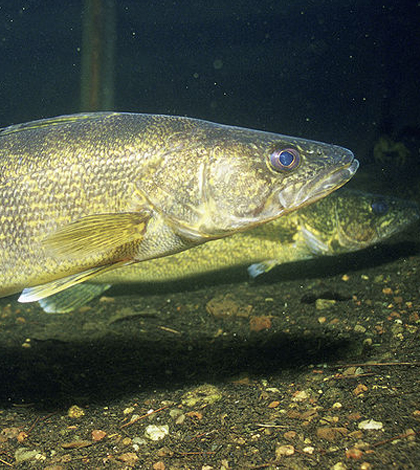Walleye

Walleye. (Credit: U.S. Fish and Wildlife Service)
Scientific Name: Stizostedion vitreum
Common Names: walleye, pickerel, walleyed pike
Walleye Interesting Facts
- Walleye are a member of the perch family (Percidae).
- The walleye is named for its pearlescent eye, which is caused by a reflective layer of pigment called the tapetum lucidum, that helps them see and feed at night or in murky water.
- Walleye can reach a maximum length of about 36″ and weigh over 20 pounds.
- The Ohio state record walleye weighed over 16 pounds and was caught near Cleveland on Lake Erie.
- Walleye are native to many waters of the upper Midwest, and are stocked for sport fishing around the country.
- Adult walleye diets are composed mostly of other fish.
Walleye Distribution and Identification
Walleye are native to Lake Erie and the Ohio River and are stocked in some of Ohio’s inland reservoirs. Walleye usually have silvery or yellowish sides with a black back and white underside. They have sharp spines in their first dorsal fin and have a mouth full of short, blunt teeth. The walleye looks similar to sauger (Stizostedion canadense) and saugeye (a walleye-sauger hybrid), and distinction between the three species can sometimes be difficult. When distinguishing between percid species, there are three main characteristics for which to look. The first characteristic to inspect is the lower tip of the tail. Walleye usually have a distinctive white tip on the lower lobe of their tail. Sauger usually have at most Lakea thin white outline on the bottom of their tail, and saugeye usually have some white on the bottom of their tail, but not as much as walleye. Secondly, the markings on the dorsal (top) fin are usually quite distinctive between the three species. Sauger dorsal fins have characteristic black dots on the fin membrane between the spines, while saugeye have less distinctive blotches and walleye have only faint markings. Finally, coloration can sometimes be used to distinguish between the species. Sauger and saugeye will usually have very distinct black blotches or “saddles” on their side and back, while walleye usually have less distinct black bars. Below is a listing of distinguishing characteristics:
- Walleye: Distinct white tip on lower lobe of tail, faint marking on dorsal fin membrane (or none at all) between dorsal spines with one large black blotch at the back of the first dorsal fin (see picture above), and an absence of distinct black blotches on the side of their body.
- Sauger: Little or no white on the tail, distinct black dots on the dorsal fin membrane, distinct black blotches and saddles on the side and back of the body.
- Saugeye: Some white pigment on the lower portion of the tail, dark blotchy markings on the dorsal fin membrane, distinct black blotches on the sides and back of the body.
Walleye Biology
Walleye prefer clear lakes and rivers in the upper Midwest and Canada that contain good habitat (gravel reefs, vegetation beds, and open water) and abundant prey such as yellow perch, shiners, or shad. In Ohio, Lake Erie’s western and central basins provide a perfect balance of habitat and prey. Lake Erie has become known as the walleye capital of the world, and may hold more trophy fish than any other body of water. A multi-agency task group has been created by state agencies surrounding Lake Erie to monitor and protect the Lake Erie walleye population. Each year, a population estimate is calculated to determine catch quotas for the lake. The Lake Erie walleye stock reached its highest density in 1988 with an estimated 80 to 100 million adult walleye. In recent years, the estimate has leveled off at around 40 million adult walleye (Lake Erie Walleye Task Group Report, March 2001). The vast expanses of open water, rocky reefs for spawning, and dense forage populations are tailored to the walleye’s preferences. Walleye are also present in the Ohio River, but dams and channelization have degraded what once was desirable habitat.
A recent threat to walleye populations is genetic contamination from stocking of hybrid saugeye or non-native walleye strains. Saugeye are fertile, and backcrossing with parental walleye could lead to dilution of genetic strains. Saugeye are stocked around the Midwest because of their popularity with anglers. Saugeye tend to grow and survive better in turbid reservoir environments and are usually easier to catch than walleye. Unfortunately, the saugeye don’t always stay where they are stocked, and migrating saugeye sometimes encounter native walleye populations in connected waters. Walleye will occasionally hybridize with sauger if the two species occur in the same water bodies, but stocking of saugeye leads to much higher rates of hybridization. A combination of degraded habitats and increased stocking of hybrids poses a serious threat to naturally sustained walleye populations.
Walleye are a popular sport fish, and self-sustaining populations in natural water bodies of the Midwest should be protected to insure the resource will be available for future generations. Protecting key habitats, limiting unnecessary stocking of non-native strains, and implementing sound harvest regulations have led to improved walleye fishing throughout the Midwest. Fishing for finicky walleye has “hooked” many anglers, and the desire of these dedicated anglers to practice selective catch-and-release will only improve the future of the sport.
For more information about walleye, see these interesting pages:
- Minnesota Department of Natural Resources, walleye information page
- Ohio Division of Wildlife, walleye information page
- Lake Erie Walleye Online
- Walleye Central
- Walleye Hunter
Top image: Walleye. (Credit: U.S. Fish and Wildlife Service)




Mikhail Skopets
August 24, 2017 at 5:14 am
Are there actual data on the zander-walleye hybridisation in the wild? In the Amur River (Russia) the both species are present (both of them are non-native). Probably we will have a hybrid population here?
Pingback: FishSens Magazine | How a pro walleye angler adjusts when his spot gets popular - FishSens Magazine